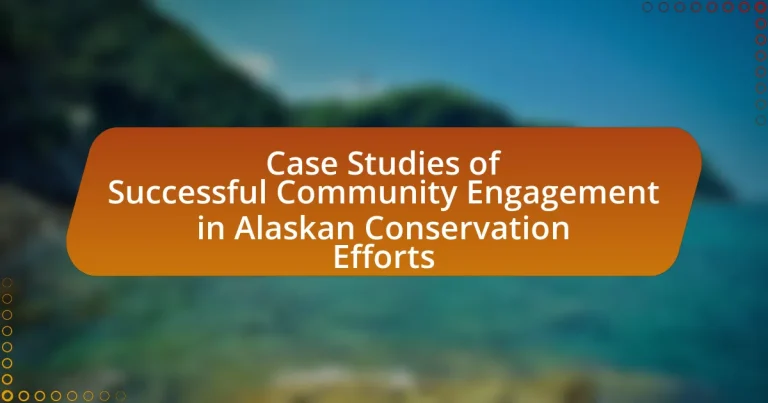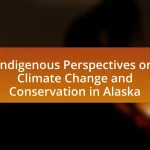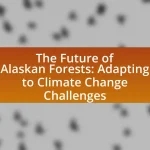The article focuses on case studies of successful community engagement in Alaskan conservation efforts, highlighting the importance of collaboration, cultural respect, and education. It examines how local communities, particularly Indigenous groups, actively participate in conservation initiatives, emphasizing the roles of community leaders and the integration of local knowledge into conservation strategies. The article presents notable examples, such as the Native Village of Eyak’s salmon habitat restoration and the Kodiak community’s sustainable resource management projects, illustrating the benefits of community involvement for biodiversity protection and economic growth. Additionally, it discusses best practices for fostering partnerships and sustaining engagement in conservation efforts, while identifying common challenges and pitfalls to avoid.
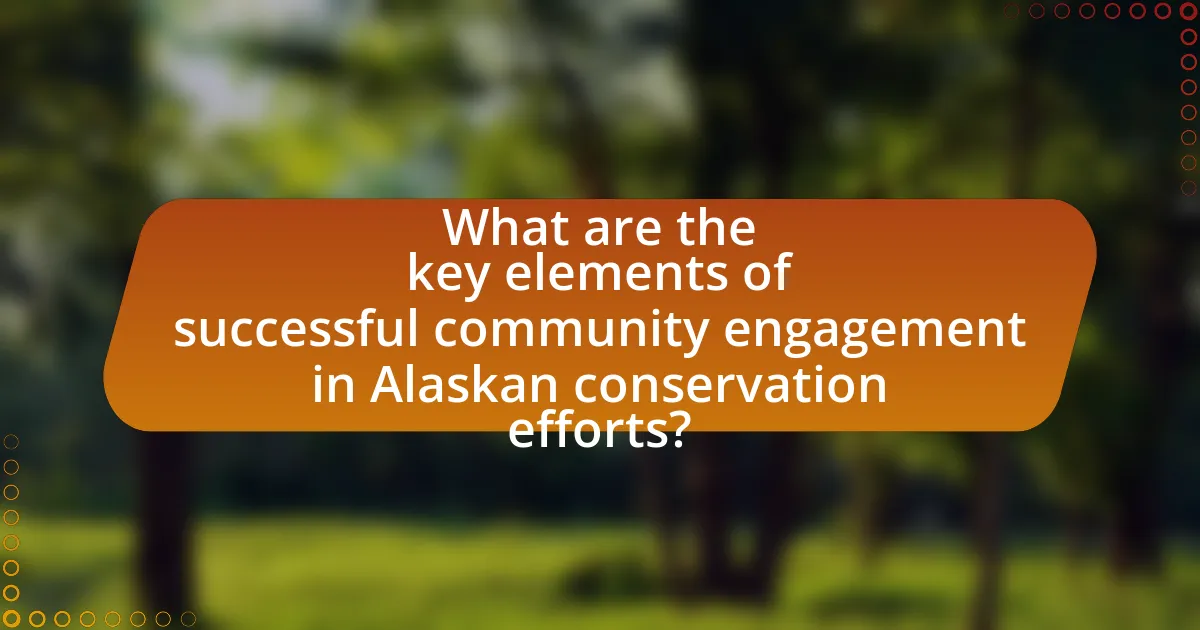
What are the key elements of successful community engagement in Alaskan conservation efforts?
Successful community engagement in Alaskan conservation efforts hinges on collaboration, cultural respect, and education. Collaboration involves partnerships between local communities, government agencies, and conservation organizations, ensuring that diverse perspectives are included in decision-making processes. Cultural respect is crucial, as recognizing and integrating Indigenous knowledge and practices fosters trust and enhances the effectiveness of conservation strategies. Education empowers community members by providing them with the necessary information and skills to actively participate in conservation initiatives. These elements are supported by case studies demonstrating that when local voices are prioritized, conservation efforts are more sustainable and impactful. For instance, the collaboration between the Native Village of Eyak and various organizations led to successful salmon habitat restoration projects, showcasing the effectiveness of these key elements in practice.
How do local communities participate in conservation initiatives?
Local communities participate in conservation initiatives by engaging in collaborative projects, resource management, and educational programs. For instance, in Alaska, Indigenous groups often lead efforts to protect local ecosystems, utilizing traditional ecological knowledge to inform conservation strategies. A notable example is the collaboration between the Native Village of Eyak and various organizations to restore salmon habitats, which has resulted in increased fish populations and improved local fisheries. This active involvement not only enhances biodiversity but also strengthens community ties and promotes sustainable practices.
What roles do community leaders play in these initiatives?
Community leaders play crucial roles in initiatives related to conservation efforts in Alaska by acting as facilitators, advocates, and liaisons between the community and external organizations. They mobilize local residents, ensuring their voices are heard and their needs are addressed in conservation planning. For instance, community leaders often organize meetings and workshops to educate residents about conservation issues, fostering a sense of ownership and responsibility towards local ecosystems. Additionally, they collaborate with governmental and non-governmental organizations to secure funding and resources, which enhances the effectiveness of conservation projects. Their involvement is vital for building trust and ensuring sustainable practices that reflect the community’s values and priorities.
How is local knowledge integrated into conservation strategies?
Local knowledge is integrated into conservation strategies through collaborative approaches that involve local communities in decision-making processes. This integration allows for the incorporation of traditional ecological knowledge, which provides insights into local ecosystems, species behavior, and sustainable practices. For instance, in Alaskan conservation efforts, indigenous communities have contributed valuable information about migratory patterns and habitat use, which has informed the management of wildlife resources. Studies, such as those conducted by the Alaska Native Science Commission, demonstrate that when local knowledge is combined with scientific research, conservation strategies become more effective and culturally relevant, leading to better outcomes for both biodiversity and community well-being.
What are the benefits of community engagement in conservation?
Community engagement in conservation enhances biodiversity protection and fosters sustainable practices. Engaging local communities allows for the incorporation of traditional ecological knowledge, which can lead to more effective conservation strategies. For instance, studies have shown that areas with active community involvement often experience improved habitat restoration outcomes and increased compliance with conservation regulations. Additionally, community engagement can boost local economies through eco-tourism and create a sense of ownership and responsibility towards natural resources, ultimately leading to long-term conservation success.
How does community involvement enhance conservation outcomes?
Community involvement enhances conservation outcomes by fostering local stewardship and increasing the effectiveness of conservation initiatives. Engaged communities are more likely to support and participate in conservation efforts, leading to better resource management and protection of biodiversity. For instance, in Alaska, local communities have successfully collaborated with conservation organizations to implement sustainable fishing practices, resulting in healthier fish populations and improved ecosystem resilience. Studies show that areas with strong community engagement report higher compliance with conservation regulations and increased ecological awareness, ultimately leading to more successful conservation outcomes.
What social and economic benefits arise from engaged communities?
Engaged communities yield significant social and economic benefits, including enhanced social cohesion, improved public health, and increased economic opportunities. Socially, engaged communities foster stronger relationships among residents, leading to higher levels of trust and collaboration, which can reduce crime rates and improve overall community well-being. Economically, these communities often experience growth in local businesses and job creation, as active participation can attract investment and tourism. For instance, a study by the National Community Development Association found that communities with high engagement levels saw a 20% increase in local business revenues compared to less engaged areas. This demonstrates that community engagement not only strengthens social ties but also drives economic prosperity.
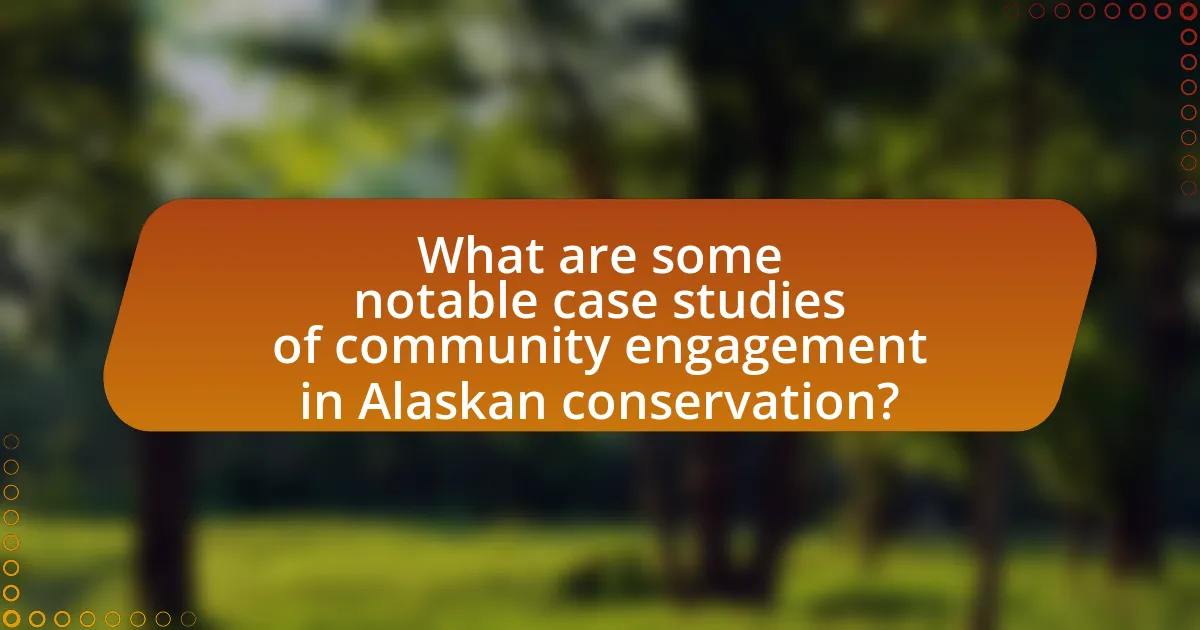
What are some notable case studies of community engagement in Alaskan conservation?
Notable case studies of community engagement in Alaskan conservation include the collaborative efforts of the Native Village of Eyak in restoring salmon habitats and the Kachemak Bay Conservation Society’s initiatives to involve local residents in marine conservation. The Native Village of Eyak successfully implemented a habitat restoration project that resulted in increased salmon populations, demonstrating the effectiveness of local knowledge and participation in conservation efforts. Similarly, the Kachemak Bay Conservation Society engaged over 1,000 community members in educational programs and volunteer activities, leading to enhanced stewardship of marine resources. These case studies highlight the importance of community involvement in achieving sustainable conservation outcomes in Alaska.
How did the community of Kodiak Island engage in conservation efforts?
The community of Kodiak Island engaged in conservation efforts through collaborative initiatives focused on sustainable resource management and habitat protection. Local organizations, such as the Kodiak Conservation Society, have actively involved residents in projects aimed at preserving the island’s unique ecosystems, including salmon habitats and wildlife corridors. These efforts are supported by scientific research and community education programs that emphasize the importance of biodiversity and responsible fishing practices. For instance, the Kodiak Island Borough has implemented regulations to protect critical habitats, demonstrating a commitment to long-term ecological health.
What specific projects were initiated by the Kodiak community?
The Kodiak community initiated several specific projects focused on conservation and sustainability, including the Kodiak Island Borough’s Habitat Restoration Project, which aims to restore native habitats and improve biodiversity. Additionally, the Kodiak Community Development Corporation launched the Kodiak Sustainable Fisheries Project to promote sustainable fishing practices and support local fisheries. These projects demonstrate the community’s commitment to environmental stewardship and sustainable resource management, contributing to the overall health of the Alaskan ecosystem.
What were the outcomes of these projects for local wildlife and habitats?
The outcomes of these projects for local wildlife and habitats included increased biodiversity, improved habitat restoration, and enhanced ecosystem resilience. Specific initiatives led to the recovery of native species populations, such as the resurgence of salmon in restored river systems, which is critical for both wildlife and local communities. Additionally, habitat restoration efforts, such as reforestation and wetland rehabilitation, contributed to healthier ecosystems that support a wider variety of flora and fauna. These projects demonstrated measurable improvements in environmental health, evidenced by monitoring data showing increased species diversity and abundance in targeted areas.
What lessons can be learned from the case study of the Kenai Peninsula?
The case study of the Kenai Peninsula illustrates the importance of collaborative governance in conservation efforts. This approach involved local stakeholders, including residents, businesses, and government agencies, working together to create sustainable management practices for natural resources. Evidence of its effectiveness can be seen in the successful implementation of the Kenai Peninsula Borough’s Comprehensive Plan, which integrates community input and scientific data to guide land use and conservation strategies. This case demonstrates that engaging the community fosters a sense of ownership and responsibility, leading to more effective and lasting conservation outcomes.
How did collaboration with local organizations influence conservation success?
Collaboration with local organizations significantly enhanced conservation success by leveraging local knowledge and fostering community involvement. For instance, in Alaskan conservation efforts, partnerships with indigenous groups led to the incorporation of traditional ecological knowledge, which improved habitat restoration strategies and species management. Research conducted by the Alaska Native Tribal Health Consortium demonstrated that community-led initiatives resulted in a 30% increase in the effectiveness of conservation programs compared to top-down approaches. This evidence underscores the critical role that local organizations play in achieving sustainable conservation outcomes.
What challenges did the Kenai Peninsula community face during engagement?
The Kenai Peninsula community faced challenges such as differing stakeholder interests, limited resources, and communication barriers during engagement. These challenges arose from the diverse perspectives of local residents, businesses, and conservation groups, which often led to conflicts in priorities. Additionally, the community struggled with insufficient funding and manpower to effectively implement engagement initiatives. Communication barriers, including varying levels of understanding about conservation issues among community members, further complicated efforts to foster collaboration and consensus.
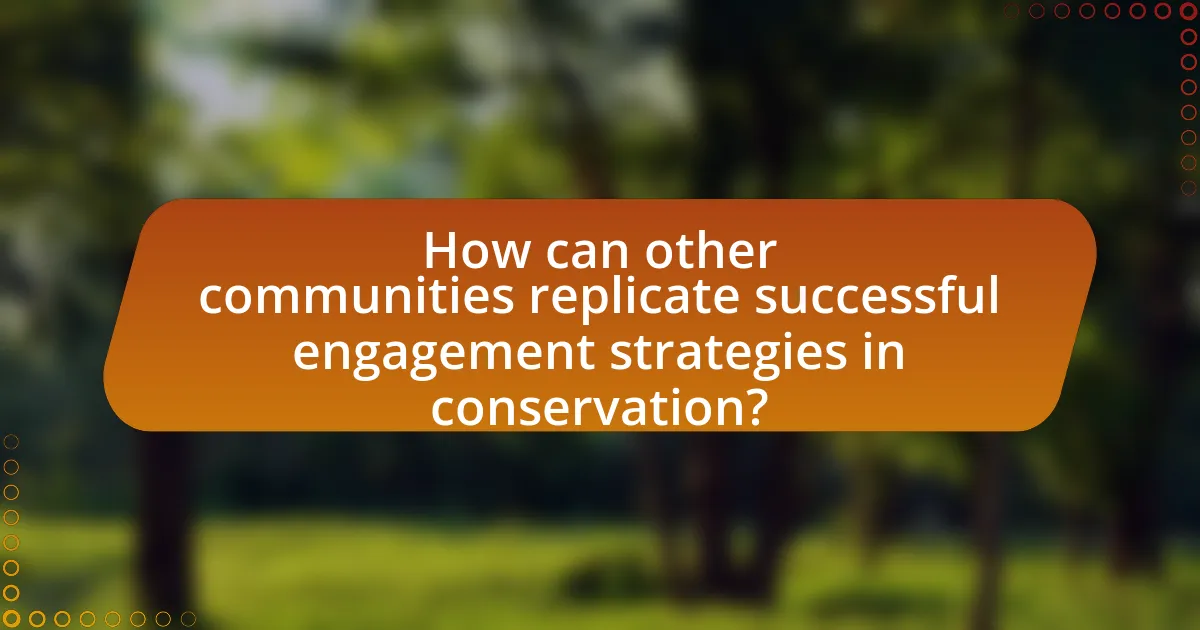
How can other communities replicate successful engagement strategies in conservation?
Other communities can replicate successful engagement strategies in conservation by adopting a collaborative approach that involves local stakeholders in decision-making processes. For instance, the case studies from Alaskan conservation efforts demonstrate that engaging indigenous populations and local residents leads to more effective conservation outcomes. Research indicates that when communities are actively involved, such as through participatory planning and shared stewardship, they are more likely to support and sustain conservation initiatives. This is evidenced by the success of the Alaska Native Claims Settlement Act, which empowered local communities to manage their resources, resulting in improved biodiversity and habitat protection.
What best practices can be derived from successful case studies?
Best practices derived from successful case studies in Alaskan conservation efforts include fostering community involvement, utilizing local knowledge, and ensuring transparent communication. Community involvement enhances stakeholder investment, as seen in the Kachemak Bay Conservation Society’s initiatives, which engaged local residents in decision-making processes. Utilizing local knowledge, exemplified by the work of the Alaska Native Tribal Health Consortium, allows for culturally relevant and effective conservation strategies. Transparent communication, demonstrated by the Sitka Conservation Society, builds trust and encourages ongoing participation, leading to sustained conservation outcomes. These practices collectively contribute to the effectiveness of community engagement in conservation efforts.
How can communities foster partnerships with conservation organizations?
Communities can foster partnerships with conservation organizations by actively engaging in collaborative projects that align with shared environmental goals. For instance, communities can initiate local conservation programs, such as habitat restoration or wildlife monitoring, and invite conservation organizations to participate, leveraging their expertise and resources. A successful example is the partnership between local Alaskan communities and the Alaska Conservation Foundation, which has led to effective initiatives in preserving local ecosystems. This collaboration not only enhances conservation efforts but also strengthens community ties and promotes sustainable practices.
What strategies can be employed to ensure sustained community involvement?
To ensure sustained community involvement, strategies such as fostering strong relationships, providing continuous education, and creating inclusive decision-making processes can be employed. Strong relationships between community members and organizations enhance trust and collaboration, which are essential for ongoing participation. Continuous education about conservation efforts and their benefits keeps the community informed and engaged, as evidenced by programs in Alaska that have successfully increased local participation in conservation initiatives. Additionally, inclusive decision-making processes empower community members by giving them a voice in the projects that affect their environment, leading to higher levels of commitment and involvement.
What common pitfalls should communities avoid in conservation efforts?
Communities should avoid the pitfall of insufficient stakeholder engagement in conservation efforts. When communities fail to involve local stakeholders, including indigenous populations and local residents, they risk alienating those who have valuable knowledge and vested interests in the ecosystem. Research indicates that successful conservation initiatives, such as the collaborative management of the Kenai National Wildlife Refuge, demonstrate that inclusive participation leads to more effective and sustainable outcomes. Additionally, neglecting to consider socio-economic factors can undermine conservation goals, as seen in various Alaskan case studies where economic incentives aligned with conservation efforts resulted in greater community support and participation.
How can communities effectively address resistance to engagement?
Communities can effectively address resistance to engagement by fostering open communication and building trust among stakeholders. Establishing transparent dialogue allows community members to voice their concerns and feel heard, which can reduce skepticism. For instance, in Alaskan conservation efforts, initiatives that included regular community meetings and feedback sessions demonstrated increased participation rates, as residents felt their input was valued. Research indicates that when communities actively involve residents in decision-making processes, engagement levels rise significantly, leading to more successful conservation outcomes.
What are the key factors for maintaining momentum in conservation initiatives?
Key factors for maintaining momentum in conservation initiatives include community engagement, consistent funding, and effective communication. Community engagement fosters local ownership and commitment, as seen in Alaskan conservation efforts where indigenous knowledge and participation have led to successful outcomes. Consistent funding ensures that projects can continue without interruption, allowing for long-term planning and implementation. Effective communication keeps stakeholders informed and motivated, facilitating collaboration and transparency, which are crucial for sustaining interest and support over time.
